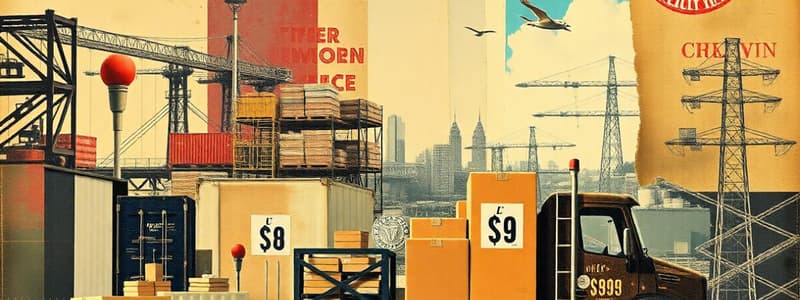Podcast
Questions and Answers
What is the primary purpose of logistics?
What is the primary purpose of logistics?
- To maximize inventory levels
- To ensure products are produced at a lower price
- To deliver products where and when needed at a lower cost (correct)
- To manage supplier relationships effectively
Which type of logistics deals with the return of products?
Which type of logistics deals with the return of products?
- Backward Logistics (correct)
- Forward Logistics
- Inbound Logistics
- Operational Logistics
What is a significant benefit of integrated logistics?
What is a significant benefit of integrated logistics?
- Optimal resource utilization (correct)
- Increased transportation costs
- High inventory levels
- Reduced customer interactions
What are the key objectives of logistics?
What are the key objectives of logistics?
Which logistical function focuses on understanding and controlling the flow of goods?
Which logistical function focuses on understanding and controlling the flow of goods?
Which of the following are pros of Green Logistics?
Which of the following are pros of Green Logistics?
What does the 3 C's module consist of?
What does the 3 C's module consist of?
Which statement is true regarding the role of planning in logistical management?
Which statement is true regarding the role of planning in logistical management?
Which stage of supply chain management focuses on relationships with channel members?
Which stage of supply chain management focuses on relationships with channel members?
What is the main goal of customer service activities?
What is the main goal of customer service activities?
Which element of customer service focuses on the policies and flexibility before a transaction occurs?
Which element of customer service focuses on the policies and flexibility before a transaction occurs?
Which of the following is NOT one of the rights of customer services?
Which of the following is NOT one of the rights of customer services?
What does a perfect order encompass in a supply chain?
What does a perfect order encompass in a supply chain?
What is one reason for conducting demand forecasting?
What is one reason for conducting demand forecasting?
Which strategy is important for improving customer service?
Which strategy is important for improving customer service?
What is one of the primary objectives of supply chain management?
What is one of the primary objectives of supply chain management?
Which of the following is a common cause of failure in achieving a perfect order?
Which of the following is a common cause of failure in achieving a perfect order?
Which of the following is NOT considered a barrier to supply chain functionality?
Which of the following is NOT considered a barrier to supply chain functionality?
Which role is primarily responsible for the flow of goods from the production point to the end-user?
Which role is primarily responsible for the flow of goods from the production point to the end-user?
What is a key difference between logistics and supply chain management?
What is a key difference between logistics and supply chain management?
What effect does the bull whip effect primarily have on manufacturing costs?
What effect does the bull whip effect primarily have on manufacturing costs?
What is a recommended solution for mitigating the bull whip effect?
What is a recommended solution for mitigating the bull whip effect?
What defines an extended enterprise in supply chain management?
What defines an extended enterprise in supply chain management?
What is a major cause of the bull whip effect?
What is a major cause of the bull whip effect?
What is the forecast for the year 2020-21 if the alpha factor is set to 0.80, actual sales for 2019 were 500000 units, and the previous forecast was 600000 units?
What is the forecast for the year 2020-21 if the alpha factor is set to 0.80, actual sales for 2019 were 500000 units, and the previous forecast was 600000 units?
What is the calculated mean squared error for 2 yearly moving averages based on the provided data?
What is the calculated mean squared error for 2 yearly moving averages based on the provided data?
If the forecast for the year 2020-22 was 10 lakh and the actual sales were 9 lakh, what is the forecast for the year 2021-22 using exponential smoothing with alpha as 0.50?
If the forecast for the year 2020-22 was 10 lakh and the actual sales were 9 lakh, what is the forecast for the year 2021-22 using exponential smoothing with alpha as 0.50?
Which of the following is NOT an advantage of forecasting?
Which of the following is NOT an advantage of forecasting?
What was the forecasted number of pensions for year 9 using a 5 yearly moving average, based on the data provided?
What was the forecasted number of pensions for year 9 using a 5 yearly moving average, based on the data provided?
What is the weighted average for the 4th year using the sales data provided?
What is the weighted average for the 4th year using the sales data provided?
What is the formula used to calculate the 5th year's weighted average?
What is the formula used to calculate the 5th year's weighted average?
Which year had a sales figure that contributed to the moving average of 135 for the 10th period?
Which year had a sales figure that contributed to the moving average of 135 for the 10th period?
How is the demand for the 10th period calculated using the moving average method?
How is the demand for the 10th period calculated using the moving average method?
What was the calculated weighted average for the 9th year demand?
What was the calculated weighted average for the 9th year demand?
Using the given data, what is the sales figure for the year 2011?
Using the given data, what is the sales figure for the year 2011?
Which of the following ratios is used to calculate the weighted average in the moving average method:
Which of the following ratios is used to calculate the weighted average in the moving average method:
What prediction does the exponential smoothing method provide for the forthcoming period?
What prediction does the exponential smoothing method provide for the forthcoming period?
Flashcards are hidden until you start studying
Study Notes
Logistics Definition
- Logistics involves delivering products and services to the right place, at the right time, and at the right price.
- It aims for cost-effectiveness.
Types of Logistics
- Forward Logistics: Movement of goods from the company to the customer (company -> distributor -> retailer/wholeseller -> customer).
- Backward Logistics: Movement of goods from the customer back to the company (customer -> retailer/wholeseller -> distributor -> company).
- Green Logistics: Focuses on minimizing the environmental impact of logistical activities through resource management, reduced pollution, and local energy production.
- Business Logistics: Involves designing and implementing the logistics systems within an organization.
- Military Logistics: Deals with the movement and supply of resources for military operations.
- Event Logistics: Plans and manages logistics for events, conferences or concerts.
Importance of Logistics
- Satisfies customer needs.
- Creates competitive advantage.
- Supports critical functions like operations and marketing.
- Helps win wars (in the case of military logistics).
- Enables integrated logistical activities.
Objectives of Logistics
- Rapid Response: Quick delivery of goods.
- Minimum Variance: Ensuring on-time delivery (OTO).
- Minimum Inventories: Reducing storage costs.
- Movement Consolidation: Combining shipments for efficiency.
- Quality: Maintaining product quality throughout the logistics process.
- Lifecycle Supports: Providing support throughout the product's lifecycle.
Functions of Logistics
- Information Systems: Managing data related to logistics.
- Warehousing: Storing goods before distribution.
- Inventory: Managing stock levels.
- Transportation: Moving goods from one point to another.
- Network Design: Designing efficient logistics networks.
- Logistical Mission: Defining the overall logistics strategy and objectives.
Planning's Role in Logistic Management
- Planning is central to logistics management.
- Involves planning and coordinating different aspects of logistics.
- Focuses on creating the right framework for logistics operations.
- Integrates various resources for efficiency.
Scope of Logistics
- Inbound Logistics: Managing the flow of materials into a company.
- Operations: Managing manufacturing and production processes.
- Outbound Logistics: Managing the flow of goods from the company to the customer.
Integrated Logistics
- Focuses on purchasing at the lowest possible cost while meeting operational needs.
- Seeks an optimal balance in managing customer, inventory and supplier flow.
Achieving Logistics Competency
- Emphasizes a step-by-step approach, starting with inbound logistics, operations, outbound logistics, and finally achieving customer service excellence through logistics.
Logistics & Marketing Interface
- Price: Logistics affects pricing strategies by impacting costs.
- Place: Logistics determines product availability and accessibility in the market.
- Product: Logistics can influence product design, packaging and handling.
- Promotion: Logistics plays a role in promoting products through timely delivery and customer service.
The 3 C's Module
- Customer: Understanding customer needs and expectations.
- Competitors: Analyzing competitors' logistics strategies.
- Company: Assessing the company's strengths and weaknesses related to logistics.
Performance Cycle of Structure of Logistics
- Procurement of Goods: The process of purchasing raw materials.
- Manufacturing Support Performance Cycle: Logistics involved in supporting the manufacturing process.
- Physical Distribution Cycle (Ex:-Water Bottle): The flow of goods from the manufacturing stage to the customer.
Green Logistics: Pros & Cons
- Pros:
- Better resource management.
- Less pollution.
- Local energy production.
- Cons:
- Lack of support from stakeholders.
- Customer resistance to potentially higher prices.
- Increased production costs.
Changing Logistical Environment
- Customer Service Explosion: Increased emphasis on customer service.
- Time Compression: Demand for quicker deliveries and faster order processing.
- Globalization of Industries: Globalized supply chains with complex logistical challenges.
- Organizational Integration: Greater collaboration between internal departments involved in logistics.
Supply Chain Management
- A network of organizations encompassing the movement of goods and finished products from the origin to the consumer.
Objectives of Supply Chain Management
- Solving supplier problems.
- Improving customer service performance.
- Minimizing variance (COTD).
- Ensuring product quality.
- Achieving maximum efficiency.
Barriers to Effective Supply Chain Management
- Organizational Barriers: Internal resistance to change and collaboration.
- Lack of Visibility: Limited information about the supply chain activities.
- Less Skills: Lack of expertise in managing complex supply chains.
- Attitude Problems: Resistance to change and collaboration.
- Inadequate Information Flow: Poor data sharing and communication.
- Distrust: Lack of trust between supply chain partners.
Participants in the Logistics Supply Chain
- Vendor: Provides raw materials or components.
- Supplier: A provider of goods or services.
- Manufacturer: Transforms raw materials into finished products.
- Customer: The end user of the product or service.
- Distributor: A middleman who distributes goods to retailers.
Functions of the Supply Chain
- Defining Business Boundaries & Relations: Establishing relationships and roles among various stakeholders
- Managing Demand & Supply: Matching supply with customer demand.
- Strengthening Logistics: Improving internal logistics operations.
- Supply Chain Integration: Integrating all aspects of the supply chain.
- Selling System Interface: Connecting with sales systems for efficiency.
- Product Design Interface: Integrating logistics with product design considerations.
- Manufacturing Interface: Connecting logistics with the production process.
Difference Between Logistics and Supply Chain Management
- Logistics: Focuses on managing resources within a company.
- Supply Chain Management: Focuses on profit maximization and managing the entire network of organizations involved in getting products and services to the end user.
Bull Whip Effect
- Increases fluctuations and variability in demand throughout the supply chain, often leading to imbalances. The effect is like a whip, with small fluctuations in the demand at the customer end leading to larger fluctuations at the manufacturing level.
- Causes:
- Lack of communication between supply chain members.
- Lack of coordination among members.
- Demand forecasting inaccuracies.
- Delays in information and material flow.
- Impact:
- Increased manufacturing costs.
- Increased inventory costs.
- Performance deterioration at all stages.
- Longer replenishment lead times.
- Solutions:
- Understanding customer demand.
- Accurate demand forecasting.
- Improved information flow.
- Free return policies.
- Reduced supplier lead times (Just-in-time).
Extended Enterprise
- A collaborative network of firms that work together to provide products and services to the market.
- Success depends on the performance of the entire network, not just individual firms.
Stages/Phases of Supply Chain Management
- Baseline: Basic level of supply chain management.
- Functional: Functional units are optimized within the supply chain.
- Internal: Internal processes within the organization are integrated.
- External: Integrating external partners in the supply chain.
Customer Service
- A collection of activities aimed at enhancing customer satisfaction.
- Focuses on meeting or exceeding customer expectations.
Objectives of Customer Service
- Perfect Order Fulfillment: Delivering orders accurately and on time.
- Improved Customer Satisfaction: Meeting or exceeding customer expectations.
- Increased Sales: Building loyalty and repeat business.
- Retaining Customers: Reducing customer churn.
- Improved Market Position: Building a strong competitive advantage.
- Customer Loyalty: Developing long-term relationships with customers.
Elements of Customer Service
- Pre-Transaction Element:
- Customer Service Policy: Establishing guidelines for customer service.
- System Flexibility: Adapting to changing customer needs.
- Organization Structure: Ensuring efficient organization and communication.
- During Transaction Element:
- Product Availability: Ensuring products are easily available.
- Current Order Status Information: Providing real-time updates.
- Goods Consistency: Maintaining consistency in order cycle time.
- Substitute Products: Offering alternatives when products are unavailable.
- Post-Transaction Element:
- After-Sales Service: Providing support after purchase.
- Product Tracing: Tracking product movements.
- Customer Grievances: Addressing customer complaints.
- Product Loaning: Providing temporary replacements for defective products.
Levels of Customer Service
- Customer Service as an Activity: Focuses on specific tasks related to customer service.
- Customer Service as a Performance Measure: Focuses on measuring and tracking customer service performance.
- Customer Service as a Philosophy: Embraces customer service as a core value and guiding principle.
Rights of Customer Service
- Right Product: Ensuring the correct product is delivered.
- Right Quantity: Delivering the correct quantity of products.
- Right Condition: Ensuring products are in good condition.
- Right Place: Delivering products to the specified location.
- Right Time: Delivering products on time.
- Right Price: Charging the correct price.
- Right Customer: Delivering products to the intended recipient.
Strategies to Improve Customer Service
- Developing a Customer Service Vision: Defining a clear vision for customer service leadership.
- Assessing Customer Needs: Understanding customer expectations and preferences.
- Hiring the Right Employees: Recruiting and retaining employees with strong customer service skills.
- Customer Service Board: Establishing a dedicated team to oversee customer service.
- Training: Providing training to enhance customer service skills.
- Accountability: Ensuring employees are accountable for providing excellent service.
- Reward & Recognition: Acknowledging and rewarding employees for outstanding customer service.
Perfect Order
- An order that is fulfilled perfectly in all aspects, including time, place, quantity, and quality.
Causes of Perfect Order Failure
- Invoicing Error: Mistakes in billing or invoicing.
- Late Arriving: Delayed delivery of products.
- Late Shipment: Shipment not made on time.
- Damaged Shipment: Products damaged during shipment.
- Order Entry Error: Mistakes in data entry during order processing.
- Error in Payment Processing: Errors in payment handling.
Demand Forecasting
- Predicting future demand for products or services.
Reasons for Demand Forecasting
- Increase Customer Satisfaction: Ensuring adequate product availability.
- Reducing Stock Outs: Preventing shortages.
- Scheduling Production Efficiently: Optimizing production planning.
- Managing Prices: Making strategic pricing decisions.
- Improving Shipping: Ensuring timely delivery.
Advantages of Forecasting
- Effective Handling of Uncertainties: Planning for potential disruptions.
- Better Labor Relations: Managing workforce needs.
- Balance Workload: Distributing work evenly.
- Minimizing Production Fluctuations: Stabilising production levels.
- Better Use of Production Facilities: Maximizing utilization.
- Better Material Management: Optimizing inventory control.
- Good Customer Service: Meeting customer expectations.
- Optimum Utilization of Resources: Making the most of available resources.
Disadvantages of Forecasting
- Inaccurate Forecasts: Forecasts are not always accurate.
- Unreliable Information: Forecasting methodologies can be unreliable.
Using Forecasting For 3 Period Weighted Moving Average
- Calculate forecasting using a weighted average of the previous 3 periods with weights as follows:
- Period 1: 3
- Period 2: 2
- Period 3: 1
- Use the following steps:
- First Year Calculation: (3 * Period 1 Demand) + (2 * Period 2 Demand) + (1 * Period 3 Demand) / (Total Weights)
- Second Year Calculation: (3 * Period 2 Demand) + (2 * Period 3 Demand) + (1 * Period 4 Demand) / (Total Weights)
- Continue the same pattern for subsequent years.
Using Exponential Smoothing for Forecasting
- The formula for exponential smoothing is:
- Forecast for the next period = (Alpha * Actual demand for the previous period) + [(1 - Alpha) * Forecast for the previous period]
- Use the following steps:
- Start with a forecast for the initial period (e.g. the first year).
- **Apply the formula to calculate subsequent forecasts. **
- The alpha factor represents the smoothing constant, which ranges between 0 and 1.
- Higher alpha values give more weight to recent data.
Using Moving Average for Forecasting
- Calculates forecasts based on the average of recent demand data.
- Types of moving average:
- 2-year moving average: Uses the average of the past two years' data.
- 5-year moving average: Uses the average of the past five years' data.
- Use the following steps:
- **Start by calculating the average values for the defined period. **
- Calculate the forecast for the subsequent year using the average.
- Continue the same pattern.
Calculating Forecasting Error
- Forecasting Error = (Actual Demand - Forecast)
- Mean Squared Error (MSE):
- Calculate the squared difference between the actual demand and forecast.
- Sum the squared errors.
- Divide the sum by the number of periods.
Studying That Suits You
Use AI to generate personalized quizzes and flashcards to suit your learning preferences.




